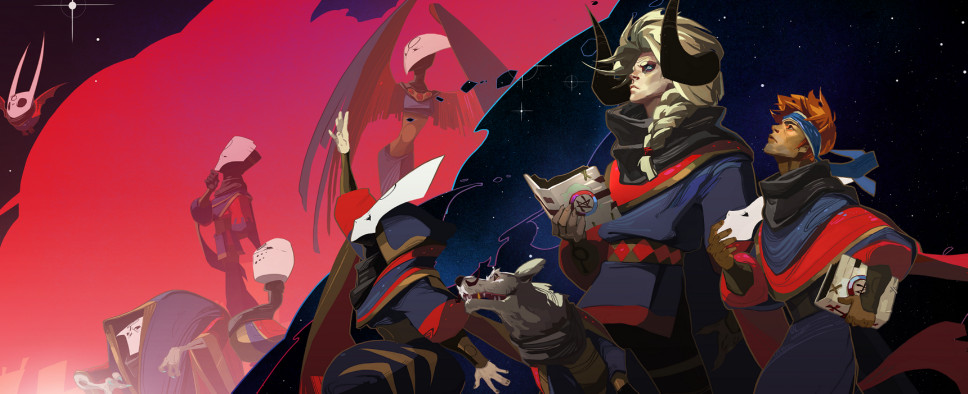Pyre Review
-
Category: ReviewsHits: 16473

Article Index
Your starting companions are a man, a horned demon, and an anthropomorphic dog with a mustache. Initially you know very little about them but as you travel together you begin to slowly gain their trust. Later on your team will grow to include a sea worm who's also a knight, a harpy with clipped wings, and a plethora of other strange characters all with their unique backstories, reasons for being exiled, and aspirations for when they get out.
This is where the game's character-driven nature comes into play. The overarching story of escaping the Downside takes the back seat to actually getting to know the people you travel with. How their stories develop depends on whose advice you take when choosing where to go, and who you pick to participate in the Rites.
Your AI opponents have their own ambitions and sometimes history with certain members of your team, adding another layer to your decision-making process. For example, one of your companions might develop a crush on one of your opponents, another one might have a sister on the opposing team, and so forth. Because of that, even though your input during the Blackwagon sections of the game is mostly limited to picking left or right, the decisions you make over time compound to create a story unique to you and you alone.
On the other hand, the overarching story suffers because of that. It doesn't get the chance to fully develop and you may even feel like you're being railroaded into a particular path that you wouldn't have ever chosen if it were up to you. Without spoiling much, the simple premise of escaping later on transforms into a noble plan to overthrow the government that had exiled you. The thing is, you go along with this plan even though you have just met the character that lays it onto you and have absolutely no reason to trust him at that point.
Main story aside, during Pyre's Blackwagon sections You make decisions that affect your team's performance in the upcoming Rites and learn more about them by doing so. You foster relationships with your teammates and spark rivalries with your opponents. You uncover things about the game's world and acquire a bunch of knickknacks and mementos along the way. You simply enjoy the journey, despite how inhospitable the Downside may be, and despite the lack of traditional gameplay elements associated with RPGs during these sections.
Add your opponents' goals that often clash with your own into the mix and the world starts to feel alive, draws you in and compels you to keep pushing forward just to learn a bit more, even though gameplay-wise you're just clicking on nodes and reading the dialogue boxes that pop up in response to that.
The Rites
The Rites are a sports-like 3 on 3 competition where most of Pyre's RPG elements come into play. Over the course of the game you acquire a roster of up to 9 players, each of them with a unique set of abilities, strengths and weaknesses.
The ultimate goal in any given Rite is to douse the opposing team's pyre by either running a player with the Celestial Orb, that's really just a fancy name for Pyre's ball, into it, or by tossing the ball into the pyre. Throwing the ball is trickier and usually awards less points but running a player in makes that player unavailable for the next drive.
You can only control one player at a time, and when you do, you can sprint, jump, pass the ball, and use the player's Aura to banish opponents from the field for several seconds. With these basics in mind, the specific movesets differ greatly between the characters. Take jumping for example - some of the characters leap short distances, others launch themselves high into the air and then descend back down knocking everyone away, and others still simply fly over the field.
The variable playstyles are further augmented by 4 stats that determine each individual player's efficiency on the field. And on top of that, each player can equip a talisman that acts as a piece of upgradable gear. Some talismans simply offer a considerable boost to one of the stats, while others offer character-specific modifiers that change the way that character plays.
As your exiles participate in the Rites they gain experience and upon leveling up, you can choose a new passive skill for them. These passive skills all offer noticeable and unique to that character benefits that shake things up a great deal, and as such the fact that each character only has a pool of 8 skills is not as bad as it may initially appear.
Moveset variety, different builds, all the talismans - if you really get into it, you'll be surprised by how complex Pyre's Rites truly are, especially considering that you're incentivized, and at certain points forced, to switch up your team composition and not get complacent with just one winning comp.
This complexity, however, is a double-edged sword. Over the course of the game I've often found myself in situations where I didn't feel completely in control. There's so much nuance to everything, that keeping track of things during the split-second decisions of the real-time Rites can be a bit tricky.
This doesn't mean that the game itself is overly difficult. In fact, the default difficulty setting feels extremely easy early on. Thankfully, it gradually becomes harder, and by the end of the game provides a satisfying level of challenge. And since challenge is a subjective thing, the developers offer three difficulty settings and optional modifiers you can use on a Rite-by-Rite basis. These modifiers make things harder for you, but in return increase the experience your exiles gain.

